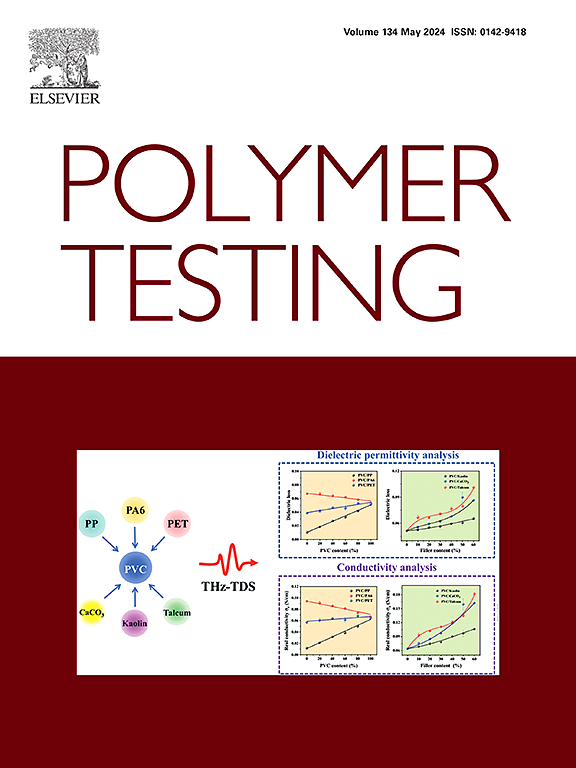FKM和FFKM o型环高温热氧化老化寿命预测及降解评价
IF 5
2区 材料科学
Q1 MATERIALS SCIENCE, CHARACTERIZATION & TESTING
引用次数: 0
摘要
为了支持太阳能反应器制氢技术的发展,本研究研究了氟化弹性体的热氧化降解机制,并预测了其在符合应用要求的高温(200-300°C)下的寿命。对FKM和FFKM o形圈及扁平样品进行加速老化程序,最长可达21天。光学显微镜用于分析暴露的密封件的形态变化,而红外显微镜用于研究两种弹性体的潜在化学降解机制。研究结果表明,FKM的降解是由聚合物的脱氢氟化引起的,随后是新形成的C=C双键氧化导致的链断裂和主链断裂。FFKM的降解主要与断链有关,但也有迹象表明,固化后的过程可能发生在材料老化期间。此外,还通过硬度、平衡压缩集(CS)、连续压缩应力松弛(CSR)和泄漏率测试来评估弹性体力学性能和密封性能的变化。平衡CS数据使用时间-温度位移(TTS)进行外推,并用于导出75%平衡CS的寿命终止标准,该标准与泄漏率高于预定阈值相关。对FKM和FFKM o型圈在不同温度下的使用寿命进行了预测,并建议密封工作温度为200℃,这确保了两种材料在太阳能反应堆中o型圈的合理更换间隔超过半年。本文章由计算机程序翻译,如有差异,请以英文原文为准。
Lifetime prediction and degradation assessment of FKM and FFKM O-rings under high temperature thermo-oxidative ageing
To support the development of solar reactor technologies for hydrogen production, this study investigates the thermo-oxidative degradation mechanisms of fluorinated elastomers and predicts their lifetimes at high temperatures (200–300 °C) consistent with the application requirements. An accelerated ageing programme is conducted with FKM and FFKM O-rings and flat samples for up to 21 days. Optical microscopy is used to analyse the exposed seals' morphological changes, while IR microscopy is utilised to investigate the underlying chemical degradation mechanisms of both elastomers. Findings suggest that FKM's degradation arises from dehydrofluorination of the polymer, followed by chain scission and backbone cleavage as a result of the oxidation of newly formed C=C double bonds. FFKM's degradation is primarily associated with chain scission, but there is also indication that post-curing processes may occur during material ageing. Furthermore, hardness, equilibrium compression set (CS), continuous compression stress relaxation (CSR) and leakage rate tests are used to evaluate changes in the mechanical properties and sealing performance of the elastomers. Equilibrium CS data is extrapolated using time-temperature shifts (TTS) and used to derive an end-of-life criterion of 75 % equilibrium CS, which correlates to leakage rates higher than a predetermined threshold. Service lifetime predictions of FKM and FFKM O-rings at several temperatures are performed and a seal operating temperature of 200 °C is suggested, which ensures reasonable O-ring replacement intervals of more than half a year in the solar reactor for both considered materials.
求助全文
通过发布文献求助,成功后即可免费获取论文全文。
去求助
来源期刊

Polymer Testing
工程技术-材料科学:表征与测试
CiteScore
10.70
自引率
5.90%
发文量
328
审稿时长
44 days
期刊介绍:
Polymer Testing focuses on the testing, analysis and characterization of polymer materials, including both synthetic and natural or biobased polymers. Novel testing methods and the testing of novel polymeric materials in bulk, solution and dispersion is covered. In addition, we welcome the submission of the testing of polymeric materials for a wide range of applications and industrial products as well as nanoscale characterization.
The scope includes but is not limited to the following main topics:
Novel testing methods and Chemical analysis
• mechanical, thermal, electrical, chemical, imaging, spectroscopy, scattering and rheology
Physical properties and behaviour of novel polymer systems
• nanoscale properties, morphology, transport properties
Degradation and recycling of polymeric materials when combined with novel testing or characterization methods
• degradation, biodegradation, ageing and fire retardancy
Modelling and Simulation work will be only considered when it is linked to new or previously published experimental results.
 求助内容:
求助内容: 应助结果提醒方式:
应助结果提醒方式:


